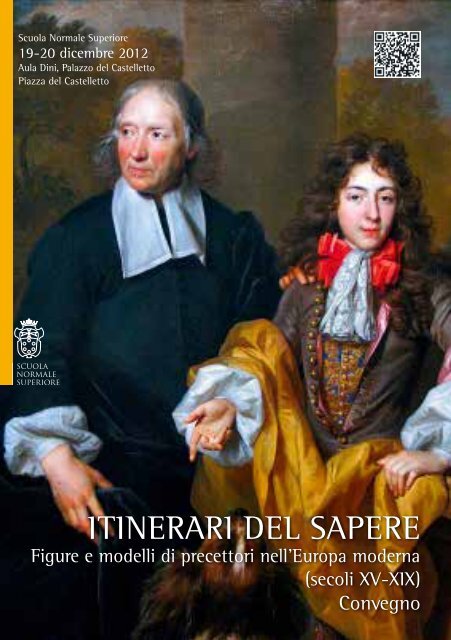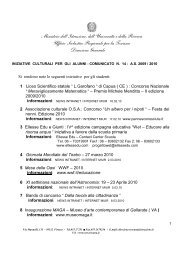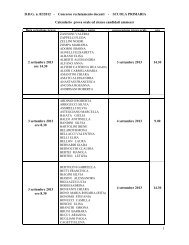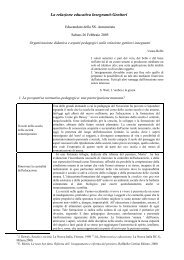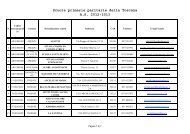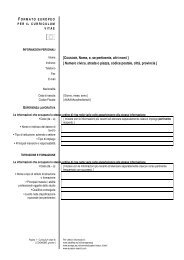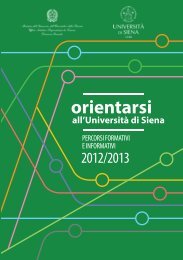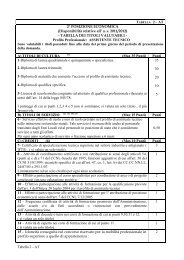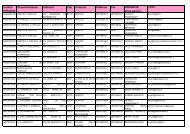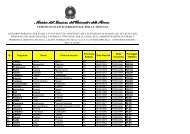Abstract (PDF) - Scuola Normale Superiore
Abstract (PDF) - Scuola Normale Superiore
Abstract (PDF) - Scuola Normale Superiore
Create successful ePaper yourself
Turn your PDF publications into a flip-book with our unique Google optimized e-Paper software.
<strong>Scuola</strong> <strong>Normale</strong> <strong>Superiore</strong><br />
19-20 dicembre 2012<br />
Aula Dini, Palazzo del Castelletto<br />
Piazza del Castelletto<br />
Itinerari del sapere<br />
Figure e modelli di precettori nell’Europa moderna<br />
(secoli XV-XIX)<br />
Convegno
Routes of Learning<br />
Convegno di studi storici<br />
Pisa, <strong>Scuola</strong> <strong>Normale</strong> <strong>Superiore</strong><br />
Programma<br />
Itinerari del sapere.<br />
Figure e modelli di precettori nell’Europa moderna<br />
(secoli XV-XIX)<br />
Routes of Learning.<br />
Figures and patterns of preceptors in Early modern Europe (XV-XIX c.)<br />
19-20 dicembre 2012<br />
Aula Dini, piazza del Castelletto, Pisa<br />
Programma<br />
Mercoledì 19 dicembre<br />
15.30 Massimo Firpo (<strong>Scuola</strong> <strong>Normale</strong> <strong>Superiore</strong>)<br />
Saluti<br />
Presiede Stefano U. Baldassarri (International Studies Institute, Firenze)<br />
15.40 Maria Pia Paoli (<strong>Scuola</strong> <strong>Normale</strong> <strong>Superiore</strong>)<br />
Introduzione<br />
16.00 Nicoletta Marcelli (Harvard University-Villa I Tatti)<br />
Gentile Becchi (1430-1497) precettore di casa Medici: un caso atipico del<br />
secondo Quattrocento<br />
Gentile Becchi (1430-1497) tutor in Medici family: an atypical teacher in the second half<br />
of XVth century<br />
16.30 Federico Piseri (Università di Pavia)<br />
“Magistri a schola” e governatori nelle corti sforzesche: un primo approccio<br />
prosopografico.<br />
“Magistri a schola” and tutors at the Sforza courts; an index of the sources.<br />
17.00 Pausa caffè<br />
17.15 Antonella Cagnolati (Università di Foggia)<br />
“The office of a tutor is firste to knowe the nature of his pupil”.<br />
Un manuale per i precettori alla corte Tudor.<br />
“The office of a tutor is firste to knowe the nature of his pupil”.<br />
A treatise for preceptors at the Tudor court.<br />
17.45 Simona Negruzzo (Università Cattolica del Sacro Cuore di Milano)<br />
L’allievo santo.Marcantonio Roccio precettore di Alessandro Luzzago.<br />
The student saint.Marcantonio Roccio tutor of Alexander Luzzago<br />
18.15 Discussione<br />
Figures and patterns of preceptors in Early modern Europe (XV-XIX c.)<br />
1
Programma<br />
Itinerari del sapere<br />
Giovedì 20 dicembre<br />
Mattina<br />
Presiede Jean Boutier (EHESS, Marseille)<br />
9.30 José María Hernández Díaz (Universidad de Salamanca)<br />
La figura pedagógica del preceptor en los ensayos y tratados de educación de<br />
nobles y principes en España,siglos XV-XVIII.<br />
Preceptor figures in pedagogical essays and treatises concerning nobles and princes education<br />
in XV-XVIII Spain.<br />
10.00 Alessandro Cont (Soprintendenza per i beni librari, archivistici e archeologici<br />
della Provincia Autonoma di Trento)<br />
Educare alla e attraverso l’amicizia.Precettori e governatori nella società<br />
nobiliare italiana del Seicento.<br />
Educate to and through the friendship. Preceptors and governors in seventeenth-century<br />
Italian noble society<br />
10.30 Monica Ferrari (Università di Pavia)<br />
Il precettore e/o il gouverneur dei principi bambini nella Francia del Sei-Settecento:<br />
questioni di potere e rapporti di forza<br />
The preceptor and / or the Gouverneur of princes and kings in France during the Seventeenth<br />
and Eighteenth Century: issues of power<br />
11.00 Pausa<br />
11.15 Andrea Bruschi (EHESS- Marseille)<br />
Dei pedagoghi a servizio delle élites europee: i precettori di lingue straniere<br />
nella Francia del Sei e Settecento<br />
Pedagogues serving European elites: foreign language teachers in 17th and 18th century<br />
France<br />
11.45 Discussione<br />
13.00 Pausa pranzo<br />
2<br />
Figure e modelli di precettori nell’Europa moderna (secoli XV-XIX)
Routes of Learning<br />
Programma<br />
Pomeriggio<br />
Presiede Mario Rosa (<strong>Scuola</strong> <strong>Normale</strong> <strong>Superiore</strong>)<br />
15.30 Patrizia Delpiano (Università di Torino)<br />
Istruzione privata e istruzione pubblica nell’Europa del Settecento:il dibattito<br />
sul ruolo del precettore.<br />
Private and Public Education in Eighteenth Century Europe: the Debate on the Role of the<br />
Preceptor<br />
16.00 Niccolò Guasti (Università di Foggia)<br />
Precettori, confessori, segretari ed amministratori: i gesuiti spagnoli espulsi e<br />
le élites italiane di fine Settecento<br />
Tutors, confessors, secretaries, administrators: Spanish expelled Jesuits and the Italian<br />
élites at the end of XVIIIth Century<br />
16.30 Andrea Gatti (Università di Ferrara)<br />
I filosofi precettori del XVIII secolo europeo. Educazione cosmopolita e Illuminismo<br />
The Philosopher as Educator in Eighteenth-Century Europe<br />
17.15 Pausa<br />
17.30 Alberto Tanturri (Università Cattolica del Sacro Cuore di Milano)<br />
Dal precettorato alle scuole private: il caso del Mezzogiorno preunitario<br />
(1806-1861)<br />
From preceptors to private schools: the case of pre-unitarian Southern Italy (1806-1861)<br />
18.00 Discussione e conclusioni<br />
Figures and patterns of preceptors in Early modern Europe (XV-XIX c.)<br />
3
<strong>Abstract</strong><br />
Itinerari del sapere<br />
Nicoletta Marcelli<br />
(Harvard University-Villa I Tatti)<br />
Gentile Becchi (1430-1497) precettore di casa Medici: un caso atipico del<br />
secondo Quattrocento<br />
Da un’analisi delle conoscenze finora acquisite sulla biografia di Becchi risulta chiaramente<br />
attestata la sua attività di precettore presso casa Medici fin dagli anni Cinquanta<br />
del Quattrocento, quando fu assunto a partire dal 1454 da Cosimo de’ Medici per<br />
educare i propri nipoti, Lorenzo e Giuliano, sebbene tale attività sembra non aver lasciato<br />
traccia concreta, soprattutto per quanto concerne la produzione di opere a chiaro<br />
fine didattico. Pertanto si fornirà un quadro, necessariamente sintetico e per sondaggi,<br />
facendo riferimento ad alcuni dei più significativi maestri del secondo Quattrocento<br />
fiorentino (Angelo Poliziano, Ugolino Verino) e non solo (Francesco Patrizi) con i quali<br />
Becchi abbia intrattenuto relazioni più o meno strette, onde dimostrare se e in che senso<br />
si possa parlare per Gentile di un precettore “atipico”.<br />
Gentile Becchi (1430-1497) tutor in the Medici family: an atypical teacher<br />
in the second half of XVth century<br />
Gentile Becchi is rather well known as tutor to Lorenzo and Giuliano de’ Medici,<br />
since he was engaged for this role by their grandfather Cosimo de’ Medici il Vecchio<br />
in 1454. Strangely enough, however, there is no surviving evidence ─ to the best of our<br />
knowledge ─ of Becchi’s didactic works. We may thus conclude that Becchi is to be<br />
considered an atypical teacher. In order to debate whether or how this statement is true,<br />
my paper will try to sketch out Gentile Becchi’s biography as well as compare him with<br />
other eminent contemporary educators both in Florence (such as Angelo Poliziano and<br />
Ugolino Verino) and abroad (Francesco Patrizi, for example), with whom Becchi was in<br />
contact especially at the early stages of his career.<br />
4<br />
Figure e modelli di precettori nell’Europa moderna (secoli XV-XIX)
Routes of Learning<br />
<strong>Abstract</strong><br />
Federico Piseri<br />
(Università di Pavia)<br />
“Magistri a schola” e governatori nelle corti sforzesche: un primo approccio<br />
prosopografico.<br />
A partire da uno spoglio sistematico dei documenti conservati presso l’Archivio<br />
di Stato di Milano, relativi alla seconda metà del XV secolo, si vogliono identificare,<br />
all’interno e all’esterno della corte, i percorsi umani e professionali delle figure, spesso<br />
sovrapposte, del maestro e del governatore dei principi figli dei duchi di Milano. Anche<br />
sulla scorta di una analisi della letteratura sul tema, tale ricerca mira a una schedatura<br />
delle fonti, in vista della ricostruzione dei rapporti all’interno della corte, delle mansioni<br />
e dei ruoli delle figure incaricate di compiti educativi. Si tratta di un’ operazione necessaria<br />
per meglio comprendere l’intreccio di competenze e professionalità che caratterizza<br />
una corte italiana del secondo Quattrocento.<br />
“Magistri a schola” and tutors at the Sforza courts; an index of sources.<br />
From a systematic examination of the sources dating from the second half of the XV<br />
century in the Archivio di Stato di Milano, this research aims to identify, within and<br />
without the court, the human and professional paths of the tutors and governors (two<br />
figures which often tend to overlap) hired by the Milanese dukes for their children. The<br />
primary intent is to index the sources, also relying on the texts relevant to this topic, so<br />
as to reconstruct the relationship (within the court), the duties and the social roles of<br />
those responsible for educational tasks. This operation is necessary in order to gain a<br />
better knowledge of the expertise and professionalism that characterized Italian Renaissance<br />
courts.<br />
Figures and patterns of preceptors in Early modern Europe (XV-XIX c.)<br />
5
<strong>Abstract</strong><br />
Itinerari del sapere<br />
Antonella Cagnolati<br />
(Università di Foggia)<br />
“The office of a tutor is firste to knowe the nature of his pupil”.<br />
Un manuale per i precettori alla corte Tudor.<br />
Nel 1531 venne pubblicato a Londra la summa delle riflessioni educative per i giovani<br />
nobili alla corte Tudor: The Boke named the Governour di Sir Thomas Elyot. L’opera<br />
si configura come un trattato per i precettori e attinge a piene mani sia dalla tradizione<br />
classica che da fonti umanistico-rinascimentali. Articolato e approfondito, il testo tocca<br />
la maggior parte delle tematiche educative con pertinenti citazioni di testi antichi ormai<br />
divenuti parte integrante della tradizione pedagogica, adattandoli intelligentemente al<br />
milieu inglese, nonché di autori contemporanei quali Erasmo da Rotterdam. Ristampato<br />
più volte nel XVI secolo, The Boke named the Governour rappresenta il più interessante<br />
tentativo di fondare in Inghilterra una peculiare ars gubernandi fondata sulla filosofia<br />
morale e sulla virtù che devono guidare ogni principe nella prassi quotidiana, sia nei<br />
confronti del proprio paese che dei sudditi.<br />
“The office of a tutor is firste to knowe the nature of his pupil”<br />
A treatise for preceptors at the Tudor court.<br />
In 1531 a ‘summa’ of educational reflections for young nobles at the Tudor court<br />
by Sir Thomas Elyot was published in London, bearing the title The Boke named the<br />
Governour. The work takes the form of a treatise for preceptors and borrows heavily<br />
from both the classical tradition and sources of Humanistic and Renaissance literature.<br />
Structured and exhaustive, the text touches on the majority of educational topics with<br />
relevant quotations from ancient texts that had by then become an integral part of the<br />
educational tradition, adapting intelligently to the English milieu, as well as from contemporary<br />
authors such as Erasmus of Rotterdam. Reprinted several times in the sixteenth<br />
century, The Boke named the Governour is the most interesting attempt in England<br />
to establish a peculiar ars gubernandi based on moral philosophy and virtue meant to<br />
guide any prince in daily practice, in regard to both his country and subjects.<br />
6<br />
Figure e modelli di precettori nell’Europa moderna (secoli XV-XIX)
Routes of Learning<br />
<strong>Abstract</strong><br />
Simona Negruzzo<br />
(Università Cattolica del Sacro Cuore di Milano)<br />
L’allievo santo. Marcantonio Roccio precettore di Alessandro Luzzago<br />
Brescia, seconda metà del Cinquecento. Il nobile Gerolamo Luzzago affida il figlio<br />
Alessandro, suo unico erede maschio, alle cure di Don Marcantonio Roccio. Gli anni<br />
di formazione, testimoniati da un memoriale composto dallo stesso Roccio in vista del<br />
processo di beatificazione di Alessandro, segnarono indelebilmente la personalità di<br />
quest’ultimo che, influenzato dalla spiritualità oratoriana e gesuitica, fu uno dei protagonisti<br />
della prima stagione controriformistica bresciana.<br />
The student saint. Marcantonio Roccio tutor to Alexander Luzzago<br />
Brescia, second half of the sixteenth century. The noble Jerome Luzzago entrusts his<br />
son Alexander, his only male heir, to the care of Don Marcantonio Roccio. The years<br />
of training, witnessed by a memorial of the same Roccio for Alexander’s beatification<br />
process, left a lasting mark on his personality. He was influenced by the spirituality of<br />
the Oratory and of the Jesuits, and was one of the protagonists of the first season of the<br />
Counter-Reformation in Brescia.<br />
7<br />
Figures and patterns of preceptors in Early modern Europe (XV-XIX c.)
<strong>Abstract</strong><br />
Itinerari del sapere<br />
José María Hernández Díaz<br />
(Universidad de Salamanca)<br />
La figura pedagógica del preceptor en los ensayos y tratados de educación<br />
de nobles y principes en España,siglos XV-XVIII.<br />
En la España de los siglos XV-XVIII, etapa de máximo esplendor y proyección exterior<br />
de un imperio en cuyos territorios nunca se ponía el sol (así sucedió sobre todo<br />
con Felipe II en la segunda mitad del siglo XVI), se configura un estamento noble más<br />
comprometido en la política que en la guerra, y también mucho más refinado y culto<br />
que la nobleza de los siglos medievales precedentes. La nueva concepción de la política<br />
demandaba formas más cortesanas y elaboradas de relación , y más asentadas en la<br />
razón. Se imponía la fuerza de la razón por encima de la razón de la fuerza. En ese nuevo<br />
marco y estilo de formas de gobierno y de relaciones sociales comienza a ganar influencia<br />
el factor de la cultura y la educación. Los nobles y futuros príncipes adoptan nuevos<br />
modales y expresiones culturales, y por ello precisan de especialistas que manejen bien<br />
las artes de la excelente formación y educación de un grupo de élites que deben formarse<br />
para ejercer el gobierno de sus inmensos territorios con inteligencia, sensatez,<br />
justicia y respeto a las normas cristianas de concebir el mundo, y desde el siglo XVI las<br />
explícitamente católicas. Es entonces cuando gana influencia la figura del preceptor, recuperando<br />
la tradición clásica del mundo grecolatino. Por ello al preceptor se le concede<br />
tanta importancia en los numerosos tratados de educación de nobles y príncipes que se<br />
escriben y editan en España en los siglos ya mencionados.<br />
8<br />
Figure e modelli di precettori nell’Europa moderna (secoli XV-XIX)
Routes of Learning<br />
<strong>Abstract</strong><br />
Preceptor figures in pedagogical essays and treatises concerning the<br />
education of nobles and princes in XV-XVIII Spain.<br />
In XV-XVIII Spain, peak stage and outreach of an empire on whose territories the<br />
sun never set (it happened especially with Philip II in the second half of the sixteenth<br />
century), one finds a nobleman more engaged in politics than in war, and also much<br />
more refined and cultured than the nobility of previous medieval centuries. The new<br />
idea of politics called for courtiers and rationalized forms of relationships. It imposed<br />
the force of reason over the logic of force. In this new scenario of styles, kinds of government<br />
and social relations, culture and education begin to gain influence. Nobles and<br />
future princes adopt new manners and cultural expressions, thus demanding specialists<br />
to properly handle the difficult art of training and educating an elite group that must be<br />
shaped so as rule over its vast territories with intelligence, wisdom, justice and respect<br />
for the Christian worldview, paying particular attention to sixteenth-century Catholicism.<br />
That’s when the preceptor gains relevant and significant influence by recovering<br />
the classical tradition of the Greco-Roman world. The tutor is thus given remarkable<br />
importance in the field of education, authoring and publishing numerous treaties for<br />
nobles and princes in Spain during the centuries mentioned above.<br />
9<br />
Figures and patterns of preceptors in Early modern Europe (XV-XIX c.)
<strong>Abstract</strong><br />
Itinerari del sapere<br />
Alessandro Cont<br />
(Soprintendenza per i Beni librari, archivistici e archeologici<br />
della Provincia autonoma di Trento)<br />
Educare alla e attraverso l’amicizia.<br />
Precettori e governatori nella società nobiliare italiana del Seicento.<br />
Benché nell’ultimo decennio l’amicizia sia divenuta un terreno d’indagine molto frequentato<br />
dagli storici dell’età moderna, il ruolo che essa rivestì nell’educazione delle<br />
élites di potere dell’Italia barocca rimane ancor oggi ampiamente ignoto. Obiettivo della<br />
relazione è colmare almeno in parte le lacune, acquisendo nuovi elementi di conoscenza<br />
utili a illuminare meglio le funzioni e l’attività delle persone preposte all’istruzione<br />
dei giovani aristocratici nell’Italia centro-settentrionale del Seicento. Grazie all’apporto<br />
di numerose lettere inedite, di opere teoriche e di testi normativi dell’epoca, è infatti<br />
possibile approfondire quale o quali modelli di amicizia i governatori, precettori e maestri<br />
cercassero di infondere nei loro allievi nel contesto della formazione del “cavaliere<br />
cristiano”, del “galanthuomo” e dell’“huomo di corte”. Ma da racconti epistolari vivaci<br />
e talora sorprendenti riaffiorano pure le resistenze che gli insegnamenti sull’amicizia<br />
suscitavano negli adolescenti, tra palazzi di famiglia e collegi, tra corti e accademie. E<br />
ancora, il materiale archivistico e librario aiuta a svelare le condizioni più favorevoli<br />
all’evolversi di un rapporto caratterizzato da reciproca amicizia fra precettore e nobile<br />
allievo, e in questa eventualità quali problematiche ne derivassero in fatto di strategie<br />
pedagogiche e di convenienze sociali.<br />
10<br />
Figure e modelli di precettori nell’Europa moderna (secoli XV-XIX)
Routes of Learning<br />
<strong>Abstract</strong><br />
Educating to and through friendship. Preceptors and governors in seventeenth-century<br />
Italian noble society.<br />
Although in the last decade friendship has become a very popular field of investigation<br />
by historians of the early modern period, the role it played in the education of<br />
power elites in the Italian baroque age is still largely unknown. The aim of this paper is<br />
to fill these gaps at least partially, thus providing new knowledge to illuminate the functions<br />
and activities of those responsible for the education of young aristocrats in central<br />
and northern Italy during the 17th century. Thanks to many unpublished letters, to theoretical<br />
works and normative texts of the time, it is possible to investigate which models<br />
of friendship the governors, preceptors and teachers tried to instil in their students in<br />
the context of the upbringing of a “christian knight”, a “gentleman”, and a “courtier”.<br />
And yet, from vivacious and sometimes surprising epistolary stories sometimes one can<br />
detect the resistance that the teachings on friendship elicited from adolescents in family<br />
palaces, colleges, courts and academies. Also, the archival and library materials help to<br />
reveal the more favorable conditions for the evolution of a relationship characterized by<br />
mutual friendship between a teacher and a noble disciple, and ─ through this process ─<br />
what issues derived in terms of pedagogical strategies and social conventions.<br />
11<br />
Figures and patterns of preceptors in Early modern Europe (XV-XIX c.)
<strong>Abstract</strong><br />
Itinerari del sapere<br />
Monica Ferrari<br />
(Università di Pavia)<br />
Il precettore e/o il gouverneur dei principi bambini nella Francia del<br />
Sei-Settecento: questioni di potere e rapporti di forza<br />
La formazione dei “Grandi” e, soprattutto, quella dei principi destinati a governare<br />
avviene per secoli, non solo in Francia, grazie al modello del precettorato privato e particolare.<br />
Nella Francia del Sei- Settecento tale modello educativo viene discusso radicalmente<br />
e non solo perché è in questione l’essenza stessa della condizione dei principi. Se<br />
il dibattito secentesco aveva già posto il problema del ruolo del precettore in rapporto<br />
alle altre figure dell’entourage del Delfino, nel Settecento il confronto si esaspera e il<br />
compito del precettore appare a molti intrinsecamente aporetico. Sia nelle Memorie di<br />
Rousseau intorno alla sua esperienza di educatore dei figli di Monsieur de Mably, sia nel<br />
dibattito coevo, emerge la questione dei rapporti di forza che travaglia la condizione del<br />
précepteur e/o del gouverneur dei bambini socialmente sovraordinati a chi li educa in<br />
una società di antico regime. Nel saggio ci si propone quindi di riflettere sul tema delle<br />
contraddizioni e dei rapporti di forza propri dell’éducation princière nella Francia del<br />
Sei-Settecento, sulla scorta dell’analisi della più recente letteratura al riguardo.<br />
The preceptor and / or the ‘Gouverneur’ of princes and kings in France<br />
during the seventeenth and eighteenth century: issues of power<br />
For centuries, the education of the powerful and, above all, of kings and princes destined<br />
to rule (not only in France) followed the model of the private and particular preceptors.<br />
In France, during the seventeenth and eighteenth century, this educational model<br />
was thoroughly criticized, not only by virtue of its addressing the very essence of the<br />
princes’ status and power. The seventeenth-century debate had already raised the issue<br />
of the role of the preceptor in relation to other figures in the entourage of the dauphin<br />
and the princes. In the following century the role of tutor was regarded as inherently<br />
complex and contradictory. Both in Rousseau’s Memoirs, concerning his experience as<br />
a preceptor of the children of Monsieur de Mably, and in the contemporary debate one<br />
finds the question of power relations between the ‘précepteur’ and / or ‘gouverneur’ on<br />
one hand and the children he educates (who are socially more important than him) on<br />
the other. In this paper we propose, therefore, to analyze the contradictions and power<br />
relations in the ‘éducation princière’ of the seventeenth and eighteenth century in France.<br />
In doing so, we will also rely on an analysis of the literature recently devoted to this topic.<br />
12<br />
Figure e modelli di precettori nell’Europa moderna (secoli XV-XIX)
Routes of Learning<br />
<strong>Abstract</strong><br />
Andrea Bruschi<br />
(EHESS- Marseille)<br />
Dei pedagoghi a servizio delle élites europee:<br />
i precettori di lingue straniere nella Francia del Sei e Settecento<br />
Lo studio dei manuali e dizionari di lingue moderne pubblicati a Parigi ed in Francia<br />
tra il Sei e il Settecento, della stampa periodica dell’epoca e di alcune fonti memorialistiche<br />
permette di ricostruire, almeno parzialmente, le pratiche legate all’attività dei<br />
precettori di vernaculaires (per limitarsi ai maestri d’italiano, Jean Vigneron, Annibale<br />
Antonini, M de La Lande…).<br />
La mia comunicazione si articolerebbe su tre punti:<br />
-la progressiva professionalizzazione dei precettori di lingue straniere. Questi costituiscono,<br />
a partire della seconda metà del XVII secolo, un gruppo ben definito, che<br />
trova nella pubblicazione o nell’affissione di annunci un efficace strumento di autopromozione<br />
e nella nobiltà straniera di passaggio nella capitale francese una parte considerabile<br />
della propria clientela;<br />
-la varietà degli insegnamenti dispensati e della produzione dei precettori. In rapporto<br />
alle esigenze di formazione della nobiltà, molti istitutori insegnano più di una<br />
lingua e delle discipline tipicamente nobiliari come la storia, la geografia, l’araldica; conoscendo<br />
il latino e più idiomi moderni, essi possono essere impiegati come<br />
interpreti e accompagnatori dei gentiluomini stranieri durante il loro tour. Tale diversificazione<br />
si riflette nella produzione che i maestri di lingue ci hanno lasciato: oltre<br />
alle grammatiche ed ai dizionari, alcuni di loro pubblicano guide turistiche destinate a<br />
circolare, in traduzione o in versione originale, in tutta Europa;<br />
-l’elaborazione di un metodo d’insegnamento linguistico trans-nazionale. Nonostante<br />
il definitivo abbandono del latino come metalingua, il ricorso all’apparato lessicale<br />
e concettuale ereditato dalla didattica delle lingue classiche consente ai precettori<br />
di idiomi moderni di fondare il proprio metodo d’insegnamento su categorie note a<br />
chiunque abbia seguito un cursus scolastico, indipendentemente dalla lingua e dalla<br />
regione d’origine. I corsi ed i manuali di questi maestri divengono così accessibili ad un<br />
pubblico poliglotta quale quello delle élites europee.<br />
Figures and patterns of preceptors in Early modern Europe (XV-XIX c.)<br />
13
<strong>Abstract</strong><br />
Itinerari del sapere<br />
Pedagogues serving European elites: foreign language teachers in 17 th and<br />
18 th century France<br />
Through the study of some modern language manuals and dictionaries published<br />
in Paris and throughout France between the 17th and the 18th century, as well as the<br />
periodical press and a few memoirs of the time, one can reconstruct, at least partially,<br />
the teaching practices of vernacular language preceptors, such as ─ to mention only<br />
some teachers of Italian ─ Jean Vigneron, Annibale Antonini and M. de La Lande. One<br />
of the topics I intend to tackle is the progressive professionalization of modern language<br />
teachers. From the second half of the 17th century, they formed a clearly defined group,<br />
using press advertisement as an effective means of self-promotion and finding a substantial<br />
part of their clientele among foreign noblemen travelling in France.<br />
14<br />
Figure e modelli di precettori nell’Europa moderna (secoli XV-XIX)
Routes of Learning<br />
<strong>Abstract</strong><br />
Patrizia Delpiano<br />
(Università di Torino)<br />
Istruzione privata e istruzione pubblica nell’Europa del Settecento:<br />
il dibattito sul ruolo del precettore<br />
L’intervento analizza la figura del precettore nel quadro del vivace dibattito che caratterizzò<br />
l’Europa del Settecento su vantaggi e svantaggi dell’istruzione privata e pubblica,<br />
nonché sulle diverse funzioni dei due modelli educativi. Dopo una riflessione<br />
sul significato delle parole «privato» e «pubblico» nel campo dell’istruzione in Antico<br />
Regime, si dà voce attraverso un’analisi comparativa ad alcuni dei protagonisti che animarono<br />
la discussione nella seconda metà secolo, in una fase di importanti trasformazioni<br />
che vide molti Stati, anche in seguito alla cacciata dei gesuiti, operare in vista del<br />
controllo della sfera educativa. I protagonisti sono scelti per il loro legame con la cultura<br />
dell’Illuminismo nell’intento di comprendere se il mondo philosophique abbia espresso<br />
una posizione unanime all’interno del dibattito e di studiare così le idee forti degli illuministi<br />
in questo campo.<br />
Private and public education in eighteenth century Europe:<br />
the debate on the role of the preceptor<br />
The paper will focus on the figure of the tutor in the context of the lively debate characterizing<br />
eighteenth century Europe on advantages and disadvantages of private and<br />
public education, as well as on different functions of the two educational models. After<br />
reflecting on the meaning of the terms “private” and “public” in Old Regime education,<br />
the paper offers a comparative analysis of the way some protagonists animated the discussion<br />
in the second half of the century, a period of important changes in which many<br />
European countries, also as a result of the Jesuit expulsion, acted in order to control the<br />
educational domain. The protagonists are selected according to their relationship with<br />
Enlightenment culture, the twofold aim being to understand, first, whether the Enlightenment<br />
world expressed a unanimous opinion in the debate and, second, to study<br />
the key ideas of this philosophy in the educational field.<br />
15<br />
Figures and patterns of preceptors in Early modern Europe (XV-XIX c.)
<strong>Abstract</strong><br />
Itinerari del sapere<br />
Niccolò Guasti<br />
(Università di Foggia)<br />
Precettori, confessori, segretari ed amministratori:<br />
i gesuiti spagnoli espulsi e le élites italiane di fine Settecento<br />
Durante il 1767 più di cinquemila gesuiti appartenenti alle undici province dell’Assistenza<br />
spagnola vennero esiliati da Carlo III di Borbone nello Stato della Chiesa: il<br />
loro arrivo, che seguiva di un decennio quello dei confratelli portoghesi, produsse una<br />
serie di effetti culturali, sociali ed economici sulle comunità italiane che furono costrette<br />
ad ospitarli. Dopo un primo lustro di difficile convivenza, un buon numero di gesuiti<br />
iberici, sudamericani e filippini riuscì gradualmente a integrarsi nelle regioni italiane<br />
del Centro-Nord; l’inizio di questa nuova fase del loro esilio data dal 1773 in avanti, e<br />
cioè dall’anno della soppressione canonica dell’Ordine di Sant’Ignazio decretata Clemente<br />
XIV. Da allora fino all’arrivo dell’armata napoleonica nel 1796 gli ex gesuiti più<br />
intraprendenti, in particolare coloro che coltivavano ambizioni letterarie, riuscirono a<br />
distinguersi con sempre maggiore disinvoltura nel difficile settore dell’istruzione privata,<br />
soprattutto come precettori dei giovani rampolli delle famiglie aristocratiche e del<br />
patriziato di provincia. I segreti di questo indubbio successo sono molteplici e di varia<br />
natura: in primo luogo i gesuiti, durante il loro lungo esilio, percepirono dal governo<br />
spagnolo una pensione vitalizia, per cui essi “costavano meno” dei loro colleghi italiani<br />
poiché molto spesso si accontentavano del vitto e dell’alloggio; secondariamente, essi<br />
seppero coniugare un’istruzione tradizionale (specie in ambito umanistico) con una<br />
prudente assimilazione della cultura illuministica coeva, per cui l“offerta formativa” da<br />
essi garantita veniva incontro ad una specifica “domanda” da parte delle élites pontificie,<br />
lombarde e venete di un’istruzione tradizionale e moderna nel contempo, senza dimenticare<br />
che la condizione di stranieri conferiva una dimensione cosmopolita (se non<br />
“esotica”, nel caso dei gesuiti che si erano formati nelle colonie sudamericane) al loro<br />
insegnamento. Infine, alcuni tra gli ex gesuiti spagnoli che risiedevano o frequentavano<br />
i palazzi dell’aristocrazia italiana cumularono (o si spartirono) varie cariche o funzioni:<br />
oltre ad essere precettori, svolsero - più o meno ufficialmente - anche le mansioni<br />
di bibliotecari, segretari, amministratori e direttori spirituali dei vari componenti della<br />
casata che li ospitava o, secondo alcuni di essi, li “sfruttava”.<br />
16<br />
Figure e modelli di precettori nell’Europa moderna (secoli XV-XIX)
Routes of Learning<br />
<strong>Abstract</strong><br />
Tutors, confessors, secretaries, administrators: Spanish expelled Jesuits<br />
and the Italian élites at the end of XVIIIth Century<br />
In 1767 Charles III expelled about five thousand Jesuits belonging to the Spanish<br />
Assistance: their exile in the Papal States produced several cultural, social and economic<br />
effects on the Italian society of the time. After five years, some Iberian, American and<br />
Philippine fathers began to be appreciated by the Italian élites, especially in the northern<br />
and central parts of the peninsula: this new period started in 1773, when Clement XIV<br />
suppressed the Society of Jesus. Until the French invasion of 1796, Spanish Jesuits cultivating<br />
literary ambitions tried to enter the education sphere, mainly as private tutors<br />
of aristocratic and patrician young scions. This success originated from numerous reasons.<br />
First of all, the Spanish government granted them a life pension; as a consequence,<br />
Spanish Jesuits were “cheaper” than their italian brothers since they often were satisfied<br />
with board and lodging. Second, they offered an education which joined a traditional<br />
outlook with a modern one, linked as it was with Enlightenment culture; in other words,<br />
their “educational supply” met a specific “demand” coming from the italian élites. In addition,<br />
being foreigners gave a cosmopolitan dimension - or an “exotic” one, especially<br />
in the case of South-American Jesuits - to their teaching. Finally, several Spanish Jesuits<br />
who cohabited with Italian aristocrats or frequented their houses often held (or shared<br />
with one another) a number of offices: they were not only tutors, but also librarians,<br />
secretaries, administrators and spiritual guides, so much so that some of them complained<br />
about being exploited by their employers.<br />
17<br />
Figures and patterns of preceptors in Early modern Europe (XV-XIX c.)
<strong>Abstract</strong><br />
Itinerari del sapere<br />
Andrea Gatti<br />
(Università di Ferrara)<br />
I filosofi precettori del XVIII secolo europeo. Educazione cosmopolita e<br />
Illuminismo<br />
Questa relazione mira a indagare le premesse teoriche, il ruolo e le pratiche educative<br />
di alcune delle più rilevanti figure di precettori-filosofi del Settecento europeo. Il<br />
periodo è particolarmente interessante non solo perché alcuni dei maggiori filosofi, da<br />
Locke a lord Shaftesbury, da Berkeley a Lord Chesterfield, svolsero simile funzione, ma<br />
perché il periodo coincide con l’affermarsi da un lato della voga del Gran Tour in Italia<br />
come luogo di perfezionamento della formazione dei giovani europei – il che consente<br />
fra l’altro di mettere in evidenza l’importanza dell’educazione estetica del giovane gentiluomo<br />
o virtuoso del tempo; dall’altro, di verificare l’impatto e le conseguenze in termini<br />
educativi del diffondersi di idee illuministe, con tutte le implicazioni morali, religiose e<br />
sociali che informarono più o meno direttamente le teorie pedagogiche coeve.<br />
Alla lente dell’opera educativa dei filosofi precettori del XVIII secolo è possibile affrontare<br />
questioni relative ai rapporti culturali fra stati europei, ripercorre l’incipiente<br />
affermazione del cosmopolitismo (in Italia si sentì l’esigenza di una formazione aperta<br />
alle novità d’Europa, come mostra esemplarmente il caso di Condillac), fortuna delle<br />
nuove idee illuministe nell’ambito dei programmi educativi di filosofi che di quelle idee<br />
furono in molti casi promotori o diffusori. Inoltre, il tema consente di adempiere ad<br />
alcuni dei desiderata tematici di questo convegno: rapporto città-corte, mobilità, e naturalmente<br />
messe quanto più ampia possibile di testimonianze dirette o indirette.<br />
The philosopher as educator in eighteenth-century Europe<br />
This paper aims at reviewing the theoretical premises and educational practices of<br />
some eminent philosophers/educators in eighteenth-century Europe. This span of time is<br />
quite interesting for many reasons: first, philosophers as Locke, Shaftesbury and Berkeley<br />
were all preceptors of young noble gentlemen; besides, most of them travelled with their<br />
pupils to Italy ─ then universally acknowledged as the place for refining personal culture<br />
and taste. In doing so they revealed the primary importance ascribed to aesthetic improvement<br />
in the education of the young gentleman or ‘virtuoso’, which is a particularly relevant<br />
topic to the goals of this paper. Lastly, it allows to survey the influence of the moral,<br />
religious and social ideas of the Enlightenment on the pedagogical theories of the time.<br />
18<br />
Figure e modelli di precettori nell’Europa moderna (secoli XV-XIX)
Routes of Learning<br />
<strong>Abstract</strong><br />
Alberto Tanturri<br />
(Università Cattolica del Sacro Cuore di Milano)<br />
Dal precettorato alle scuole private: il caso del Mezzogiorno preunitario<br />
(1806-1861)<br />
Il saggio analizza il sistema delle scuole private meridionali nel periodo compreso<br />
fra il Decennio francese e il compimento dell’Unificazione nazionale. Dalla ricostruzione<br />
emerge la larga diffusione di tale tipo di scuole, dovuta ad una serie di fattori, tra cui<br />
un quadro normativo largamente permissivo, la presenza di una vasta disoccupazione<br />
intellettuale, che conduceva molti laureati a trovare nell’insegnamento un’opportunità<br />
di impiego, e la maggiore capacità della scuola privata, rispetto a quella pubblica, di<br />
adeguarsi ai bisogni dell’utenza.<br />
From preceptors to private schools: the case of pre-unitarian Southern<br />
Italy (1806-1861)<br />
This essay focuses on the private schools system in Southern Italy in the period ranging<br />
from Napoleonic age to National unification. The reconstruction points out the<br />
wide diffusion of this kind of schools, due to many factors. Among them, the most important<br />
were: the largely permissive laws on this subject, a widespread unemployement<br />
among intellectuals, which forced many graduates to find a job as private teachers, and<br />
the better capability of private schools (in comparison with their state-founded counterparts)<br />
to conform with the demands of pupils.<br />
Figures and patterns of preceptors in Early modern Europe (XV-XIX c.)<br />
19
Note<br />
Itinerari del sapere<br />
. . . . . . . . . . . . . . . . . . . . . . . . . . . . . . . . . . . . . . . . . . . . . . . . . . . . . . . . . . . . . . . . . . . . . . . . . . . . . . . . . . . . . . . . . . . . . . . . . . . . . . . . . . .<br />
. . . . . . . . . . . . . . . . . . . . . . . . . . . . . . . . . . . . . . . . . . . . . . . . . . . . . . . . . . . . . . . . . . . . . . . . . . . . . . . . . . . . . . . . . . . . . . . . . . . . . . . . . . .<br />
. . . . . . . . . . . . . . . . . . . . . . . . . . . . . . . . . . . . . . . . . . . . . . . . . . . . . . . . . . . . . . . . . . . . . . . . . . . . . . . . . . . . . . . . . . . . . . . . . . . . . . . . . . .<br />
. . . . . . . . . . . . . . . . . . . . . . . . . . . . . . . . . . . . . . . . . . . . . . . . . . . . . . . . . . . . . . . . . . . . . . . . . . . . . . . . . . . . . . . . . . . . . . . . . . . . . . . . . . .<br />
. . . . . . . . . . . . . . . . . . . . . . . . . . . . . . . . . . . . . . . . . . . . . . . . . . . . . . . . . . . . . . . . . . . . . . . . . . . . . . . . . . . . . . . . . . . . . . . . . . . . . . . . . . .<br />
. . . . . . . . . . . . . . . . . . . . . . . . . . . . . . . . . . . . . . . . . . . . . . . . . . . . . . . . . . . . . . . . . . . . . . . . . . . . . . . . . . . . . . . . . . . . . . . . . . . . . . . . . . .<br />
. . . . . . . . . . . . . . . . . . . . . . . . . . . . . . . . . . . . . . . . . . . . . . . . . . . . . . . . . . . . . . . . . . . . . . . . . . . . . . . . . . . . . . . . . . . . . . . . . . . . . . . . . . .<br />
. . . . . . . . . . . . . . . . . . . . . . . . . . . . . . . . . . . . . . . . . . . . . . . . . . . . . . . . . . . . . . . . . . . . . . . . . . . . . . . . . . . . . . . . . . . . . . . . . . . . . . . . . . .<br />
. . . . . . . . . . . . . . . . . . . . . . . . . . . . . . . . . . . . . . . . . . . . . . . . . . . . . . . . . . . . . . . . . . . . . . . . . . . . . . . . . . . . . . . . . . . . . . . . . . . . . . . . . . .<br />
. . . . . . . . . . . . . . . . . . . . . . . . . . . . . . . . . . . . . . . . . . . . . . . . . . . . . . . . . . . . . . . . . . . . . . . . . . . . . . . . . . . . . . . . . . . . . . . . . . . . . . . . . . .<br />
. . . . . . . . . . . . . . . . . . . . . . . . . . . . . . . . . . . . . . . . . . . . . . . . . . . . . . . . . . . . . . . . . . . . . . . . . . . . . . . . . . . . . . . . . . . . . . . . . . . . . . . . . . .<br />
. . . . . . . . . . . . . . . . . . . . . . . . . . . . . . . . . . . . . . . . . . . . . . . . . . . . . . . . . . . . . . . . . . . . . . . . . . . . . . . . . . . . . . . . . . . . . . . . . . . . . . . . . . .<br />
. . . . . . . . . . . . . . . . . . . . . . . . . . . . . . . . . . . . . . . . . . . . . . . . . . . . . . . . . . . . . . . . . . . . . . . . . . . . . . . . . . . . . . . . . . . . . . . . . . . . . . . . . . .<br />
. . . . . . . . . . . . . . . . . . . . . . . . . . . . . . . . . . . . . . . . . . . . . . . . . . . . . . . . . . . . . . . . . . . . . . . . . . . . . . . . . . . . . . . . . . . . . . . . . . . . . . . . . . .<br />
. . . . . . . . . . . . . . . . . . . . . . . . . . . . . . . . . . . . . . . . . . . . . . . . . . . . . . . . . . . . . . . . . . . . . . . . . . . . . . . . . . . . . . . . . . . . . . . . . . . . . . . . . . .<br />
. . . . . . . . . . . . . . . . . . . . . . . . . . . . . . . . . . . . . . . . . . . . . . . . . . . . . . . . . . . . . . . . . . . . . . . . . . . . . . . . . . . . . . . . . . . . . . . . . . . . . . . . . . .<br />
. . . . . . . . . . . . . . . . . . . . . . . . . . . . . . . . . . . . . . . . . . . . . . . . . . . . . . . . . . . . . . . . . . . . . . . . . . . . . . . . . . . . . . . . . . . . . . . . . . . . . . . . . . .<br />
. . . . . . . . . . . . . . . . . . . . . . . . . . . . . . . . . . . . . . . . . . . . . . . . . . . . . . . . . . . . . . . . . . . . . . . . . . . . . . . . . . . . . . . . . . . . . . . . . . . . . . . . . . .<br />
. . . . . . . . . . . . . . . . . . . . . . . . . . . . . . . . . . . . . . . . . . . . . . . . . . . . . . . . . . . . . . . . . . . . . . . . . . . . . . . . . . . . . . . . . . . . . . . . . . . . . . . . . . .<br />
. . . . . . . . . . . . . . . . . . . . . . . . . . . . . . . . . . . . . . . . . . . . . . . . . . . . . . . . . . . . . . . . . . . . . . . . . . . . . . . . . . . . . . . . . . . . . . . . . . . . . . . . . . .<br />
. . . . . . . . . . . . . . . . . . . . . . . . . . . . . . . . . . . . . . . . . . . . . . . . . . . . . . . . . . . . . . . . . . . . . . . . . . . . . . . . . . . . . . . . . . . . . . . . . . . . . . . . . . .<br />
. . . . . . . . . . . . . . . . . . . . . . . . . . . . . . . . . . . . . . . . . . . . . . . . . . . . . . . . . . . . . . . . . . . . . . . . . . . . . . . . . . . . . . . . . . . . . . . . . . . . . . . . . . .<br />
. . . . . . . . . . . . . . . . . . . . . . . . . . . . . . . . . . . . . . . . . . . . . . . . . . . . . . . . . . . . . . . . . . . . . . . . . . . . . . . . . . . . . . . . . . . . . . . . . . . . . . . . . . .<br />
. . . . . . . . . . . . . . . . . . . . . . . . . . . . . . . . . . . . . . . . . . . . . . . . . . . . . . . . . . . . . . . . . . . . . . . . . . . . . . . . . . . . . . . . . . . . . . . . . . . . . . . . . . .<br />
. . . . . . . . . . . . . . . . . . . . . . . . . . . . . . . . . . . . . . . . . . . . . . . . . . . . . . . . . . . . . . . . . . . . . . . . . . . . . . . . . . . . . . . . . . . . . . . . . . . . . . . . . . .<br />
. . . . . . . . . . . . . . . . . . . . . . . . . . . . . . . . . . . . . . . . . . . . . . . . . . . . . . . . . . . . . . . . . . . . . . . . . . . . . . . . . . . . . . . . . . . . . . . . . . . . . . . . . . .<br />
Figure e modelli di precettori nell’Europa moderna (secoli XV-XIX)
Routes of Learning<br />
NOTE<br />
. . . . . . . . . . . . . . . . . . . . . . . . . . . . . . . . . . . . . . . . . . . . . . . . . . . . . . . . . . . . . . . . . . . . . . . . . . . . . . . . . . . . . . . . . . . . . . . . . . . . . . . . . . .<br />
. . . . . . . . . . . . . . . . . . . . . . . . . . . . . . . . . . . . . . . . . . . . . . . . . . . . . . . . . . . . . . . . . . . . . . . . . . . . . . . . . . . . . . . . . . . . . . . . . . . . . . . . . . .<br />
. . . . . . . . . . . . . . . . . . . . . . . . . . . . . . . . . . . . . . . . . . . . . . . . . . . . . . . . . . . . . . . . . . . . . . . . . . . . . . . . . . . . . . . . . . . . . . . . . . . . . . . . . . .<br />
. . . . . . . . . . . . . . . . . . . . . . . . . . . . . . . . . . . . . . . . . . . . . . . . . . . . . . . . . . . . . . . . . . . . . . . . . . . . . . . . . . . . . . . . . . . . . . . . . . . . . . . . . . .<br />
. . . . . . . . . . . . . . . . . . . . . . . . . . . . . . . . . . . . . . . . . . . . . . . . . . . . . . . . . . . . . . . . . . . . . . . . . . . . . . . . . . . . . . . . . . . . . . . . . . . . . . . . . . .<br />
. . . . . . . . . . . . . . . . . . . . . . . . . . . . . . . . . . . . . . . . . . . . . . . . . . . . . . . . . . . . . . . . . . . . . . . . . . . . . . . . . . . . . . . . . . . . . . . . . . . . . . . . . . .<br />
. . . . . . . . . . . . . . . . . . . . . . . . . . . . . . . . . . . . . . . . . . . . . . . . . . . . . . . . . . . . . . . . . . . . . . . . . . . . . . . . . . . . . . . . . . . . . . . . . . . . . . . . . . .<br />
. . . . . . . . . . . . . . . . . . . . . . . . . . . . . . . . . . . . . . . . . . . . . . . . . . . . . . . . . . . . . . . . . . . . . . . . . . . . . . . . . . . . . . . . . . . . . . . . . . . . . . . . . . .<br />
. . . . . . . . . . . . . . . . . . . . . . . . . . . . . . . . . . . . . . . . . . . . . . . . . . . . . . . . . . . . . . . . . . . . . . . . . . . . . . . . . . . . . . . . . . . . . . . . . . . . . . . . . . .<br />
. . . . . . . . . . . . . . . . . . . . . . . . . . . . . . . . . . . . . . . . . . . . . . . . . . . . . . . . . . . . . . . . . . . . . . . . . . . . . . . . . . . . . . . . . . . . . . . . . . . . . . . . . . .<br />
. . . . . . . . . . . . . . . . . . . . . . . . . . . . . . . . . . . . . . . . . . . . . . . . . . . . . . . . . . . . . . . . . . . . . . . . . . . . . . . . . . . . . . . . . . . . . . . . . . . . . . . . . . .<br />
. . . . . . . . . . . . . . . . . . . . . . . . . . . . . . . . . . . . . . . . . . . . . . . . . . . . . . . . . . . . . . . . . . . . . . . . . . . . . . . . . . . . . . . . . . . . . . . . . . . . . . . . . . .<br />
. . . . . . . . . . . . . . . . . . . . . . . . . . . . . . . . . . . . . . . . . . . . . . . . . . . . . . . . . . . . . . . . . . . . . . . . . . . . . . . . . . . . . . . . . . . . . . . . . . . . . . . . . . .<br />
. . . . . . . . . . . . . . . . . . . . . . . . . . . . . . . . . . . . . . . . . . . . . . . . . . . . . . . . . . . . . . . . . . . . . . . . . . . . . . . . . . . . . . . . . . . . . . . . . . . . . . . . . . .<br />
. . . . . . . . . . . . . . . . . . . . . . . . . . . . . . . . . . . . . . . . . . . . . . . . . . . . . . . . . . . . . . . . . . . . . . . . . . . . . . . . . . . . . . . . . . . . . . . . . . . . . . . . . . .<br />
. . . . . . . . . . . . . . . . . . . . . . . . . . . . . . . . . . . . . . . . . . . . . . . . . . . . . . . . . . . . . . . . . . . . . . . . . . . . . . . . . . . . . . . . . . . . . . . . . . . . . . . . . . .<br />
. . . . . . . . . . . . . . . . . . . . . . . . . . . . . . . . . . . . . . . . . . . . . . . . . . . . . . . . . . . . . . . . . . . . . . . . . . . . . . . . . . . . . . . . . . . . . . . . . . . . . . . . . . .<br />
. . . . . . . . . . . . . . . . . . . . . . . . . . . . . . . . . . . . . . . . . . . . . . . . . . . . . . . . . . . . . . . . . . . . . . . . . . . . . . . . . . . . . . . . . . . . . . . . . . . . . . . . . . .<br />
. . . . . . . . . . . . . . . . . . . . . . . . . . . . . . . . . . . . . . . . . . . . . . . . . . . . . . . . . . . . . . . . . . . . . . . . . . . . . . . . . . . . . . . . . . . . . . . . . . . . . . . . . . .<br />
. . . . . . . . . . . . . . . . . . . . . . . . . . . . . . . . . . . . . . . . . . . . . . . . . . . . . . . . . . . . . . . . . . . . . . . . . . . . . . . . . . . . . . . . . . . . . . . . . . . . . . . . . . .<br />
. . . . . . . . . . . . . . . . . . . . . . . . . . . . . . . . . . . . . . . . . . . . . . . . . . . . . . . . . . . . . . . . . . . . . . . . . . . . . . . . . . . . . . . . . . . . . . . . . . . . . . . . . . .<br />
. . . . . . . . . . . . . . . . . . . . . . . . . . . . . . . . . . . . . . . . . . . . . . . . . . . . . . . . . . . . . . . . . . . . . . . . . . . . . . . . . . . . . . . . . . . . . . . . . . . . . . . . . . .<br />
. . . . . . . . . . . . . . . . . . . . . . . . . . . . . . . . . . . . . . . . . . . . . . . . . . . . . . . . . . . . . . . . . . . . . . . . . . . . . . . . . . . . . . . . . . . . . . . . . . . . . . . . . . .<br />
. . . . . . . . . . . . . . . . . . . . . . . . . . . . . . . . . . . . . . . . . . . . . . . . . . . . . . . . . . . . . . . . . . . . . . . . . . . . . . . . . . . . . . . . . . . . . . . . . . . . . . . . . . .<br />
. . . . . . . . . . . . . . . . . . . . . . . . . . . . . . . . . . . . . . . . . . . . . . . . . . . . . . . . . . . . . . . . . . . . . . . . . . . . . . . . . . . . . . . . . . . . . . . . . . . . . . . . . . .<br />
. . . . . . . . . . . . . . . . . . . . . . . . . . . . . . . . . . . . . . . . . . . . . . . . . . . . . . . . . . . . . . . . . . . . . . . . . . . . . . . . . . . . . . . . . . . . . . . . . . . . . . . . . . .<br />
Figures and patterns of preceptors in Early modern Europe (XV-XIX c.)
Organizzazione scientifica<br />
Maria Pia Paoli, <strong>Scuola</strong> <strong>Normale</strong> <strong>Superiore</strong><br />
Antonella Cagnolati, Università di Foggia<br />
Monica Ferrari, Università di Pavia<br />
Niccolò Guasti, Università di Foggia<br />
Per informazioni:<br />
Attività culturali<br />
+39 050 509307<br />
eventiculturali@sns.it


